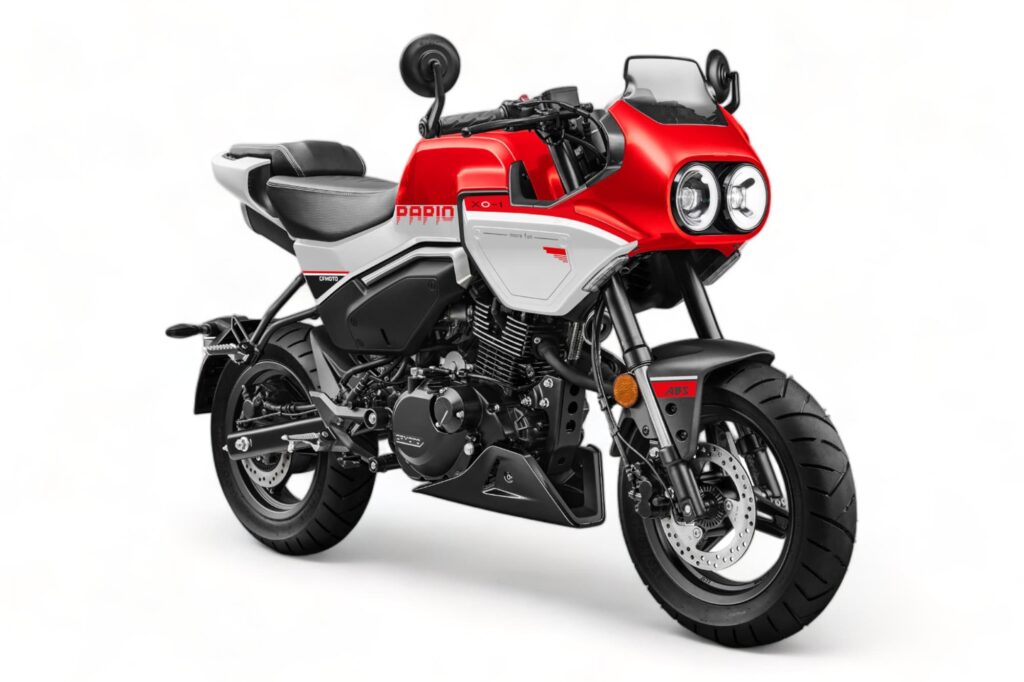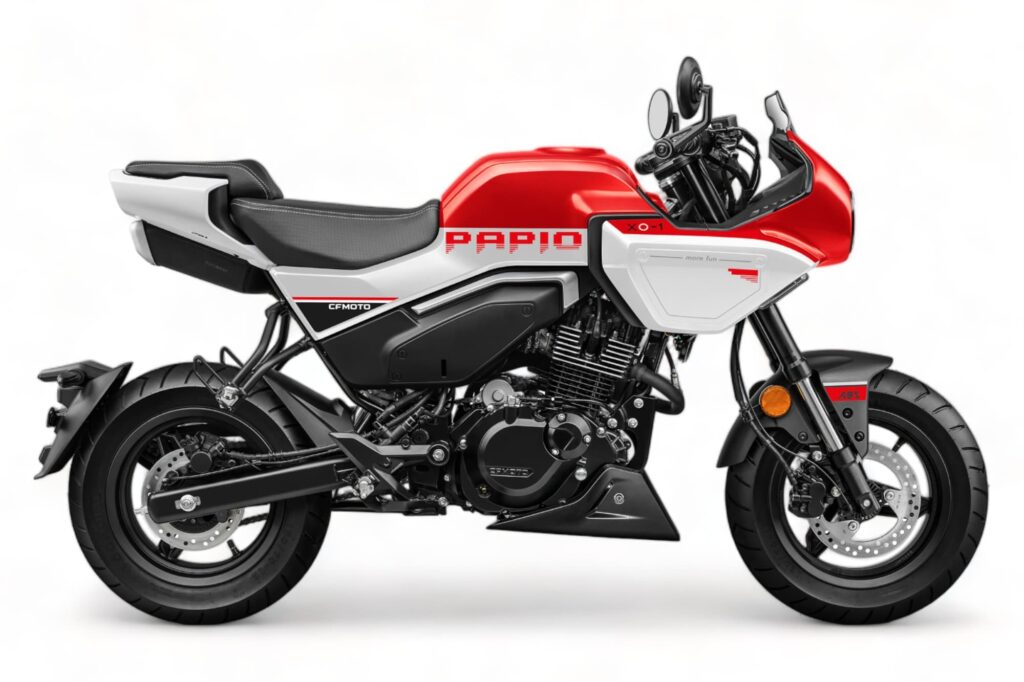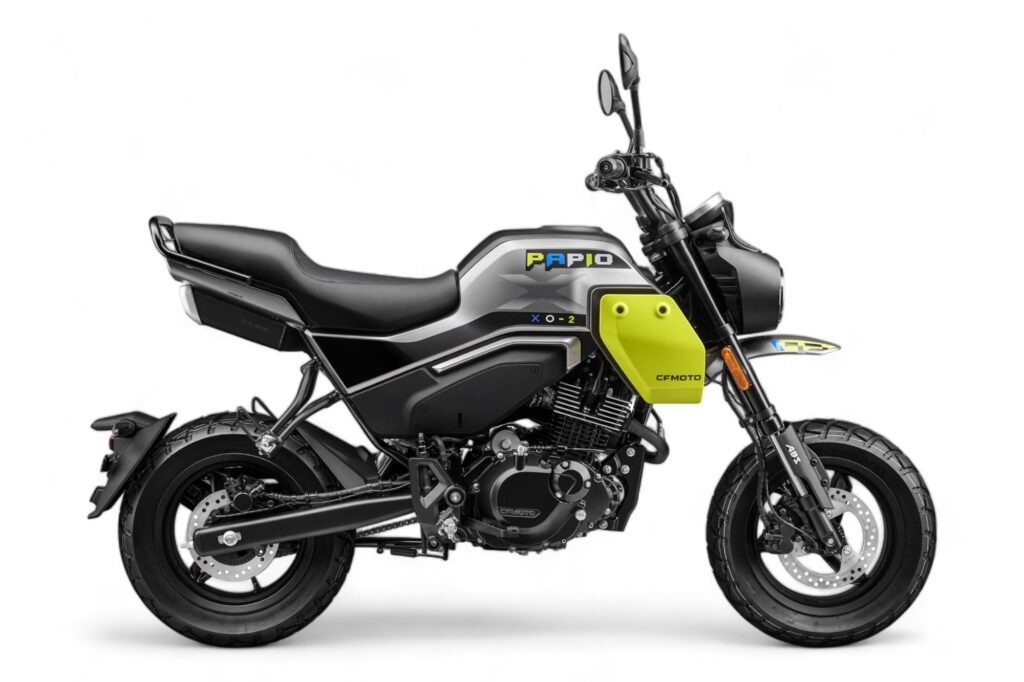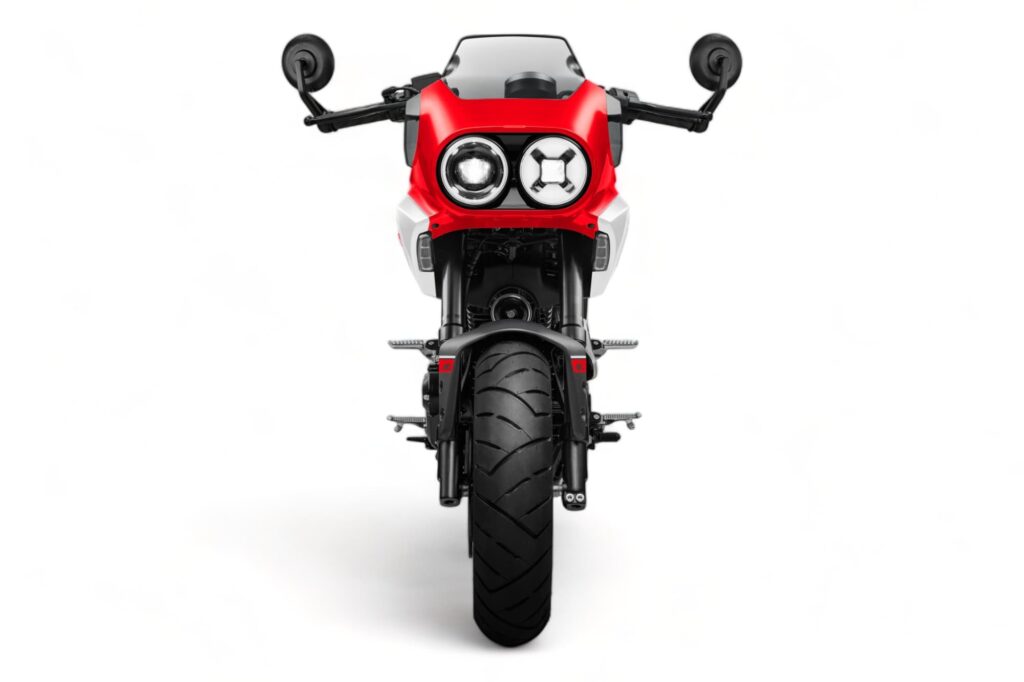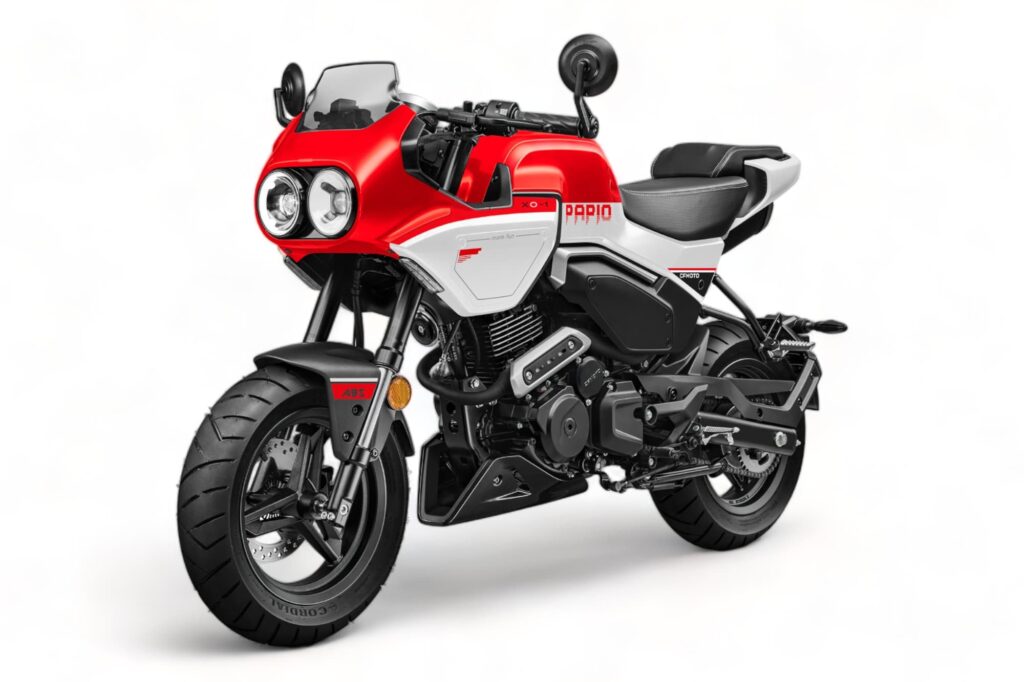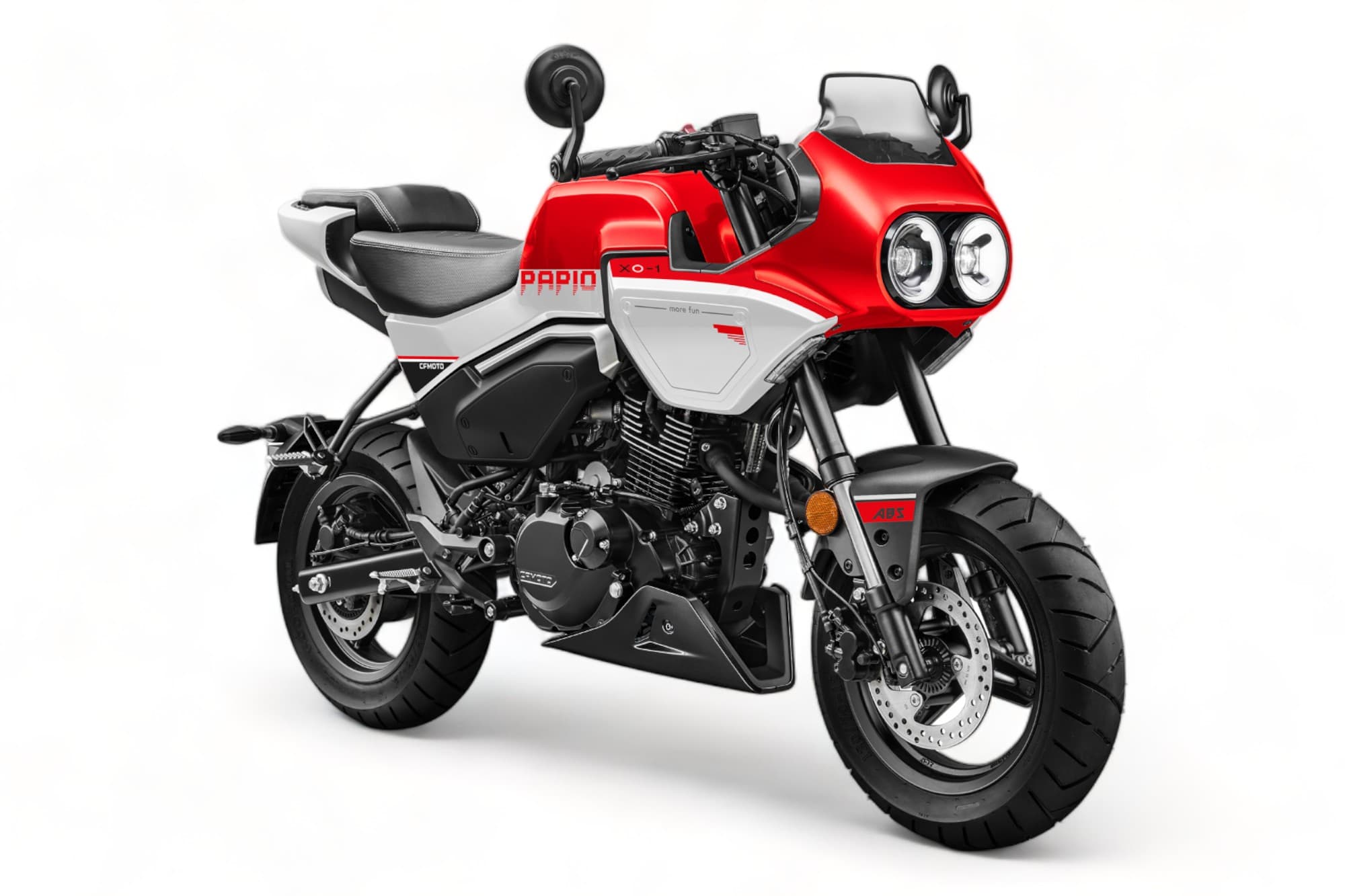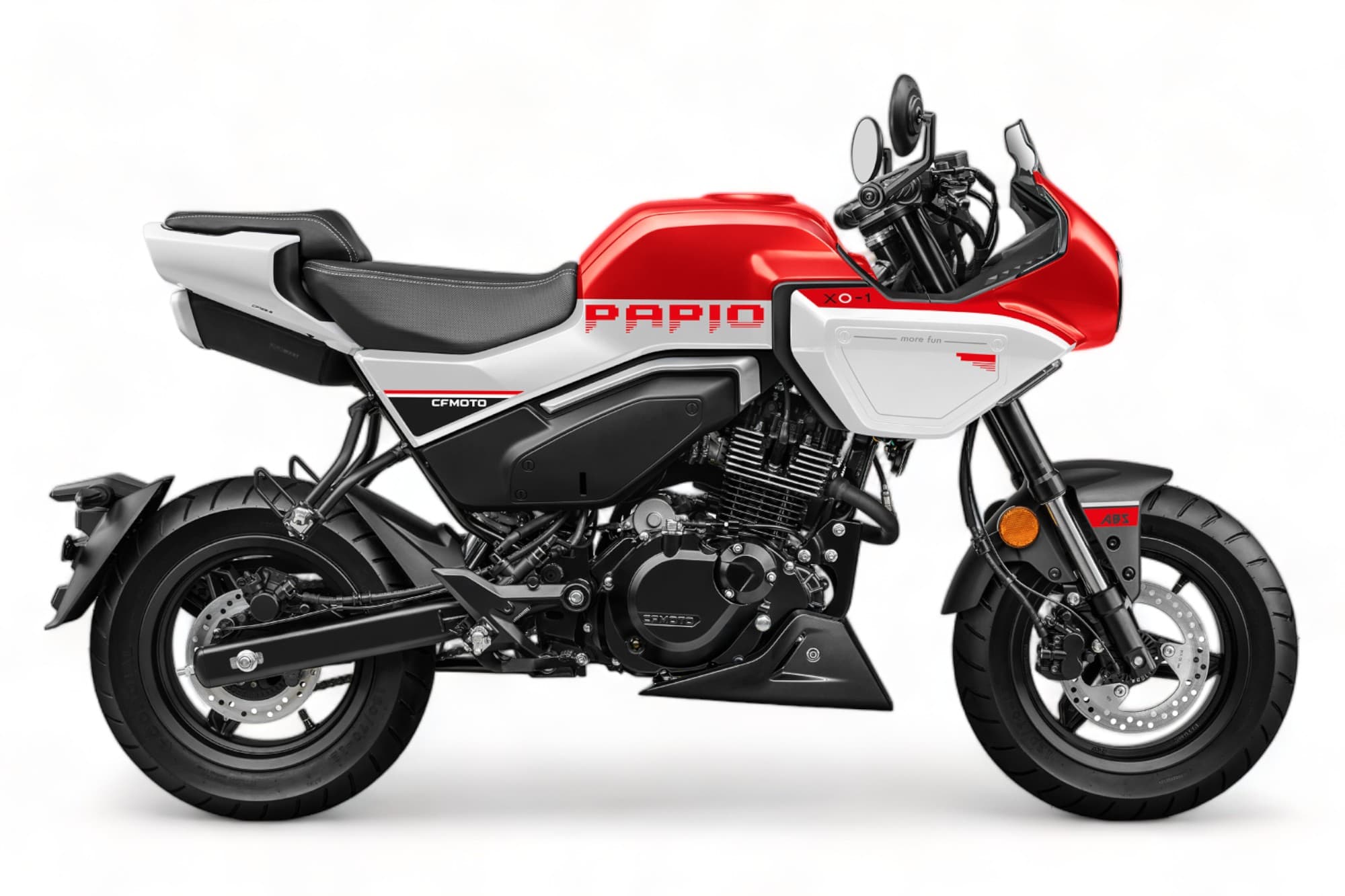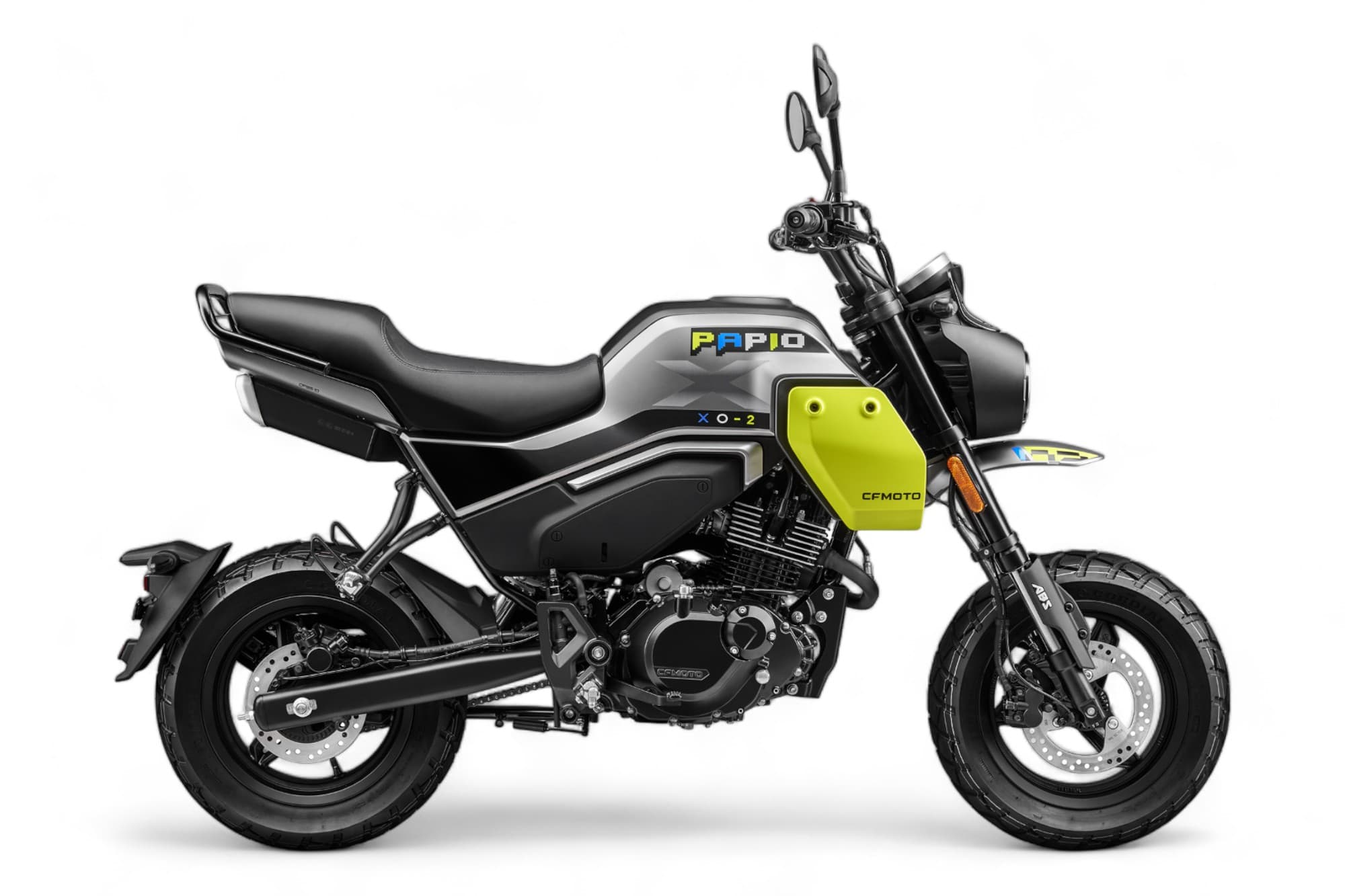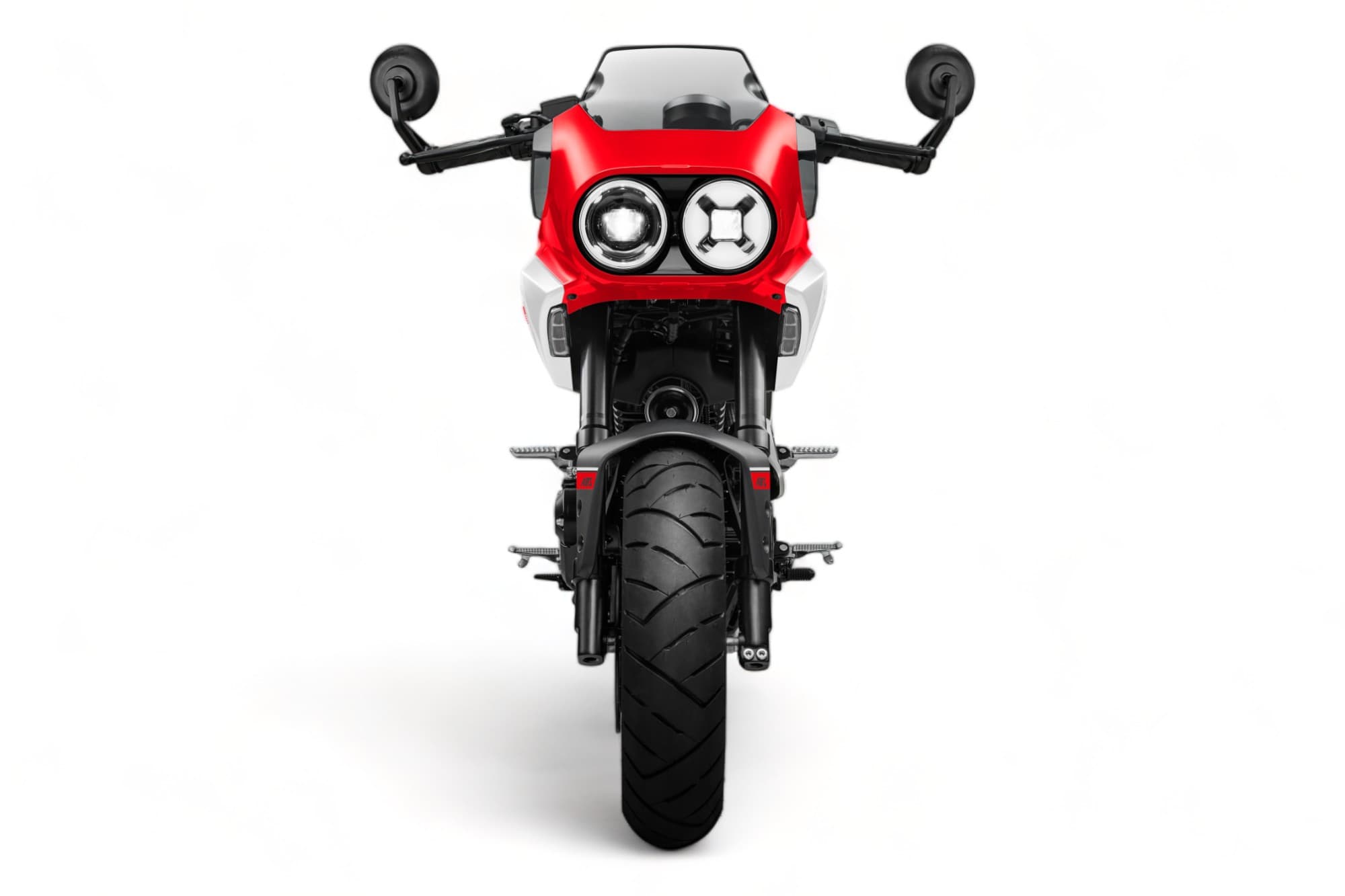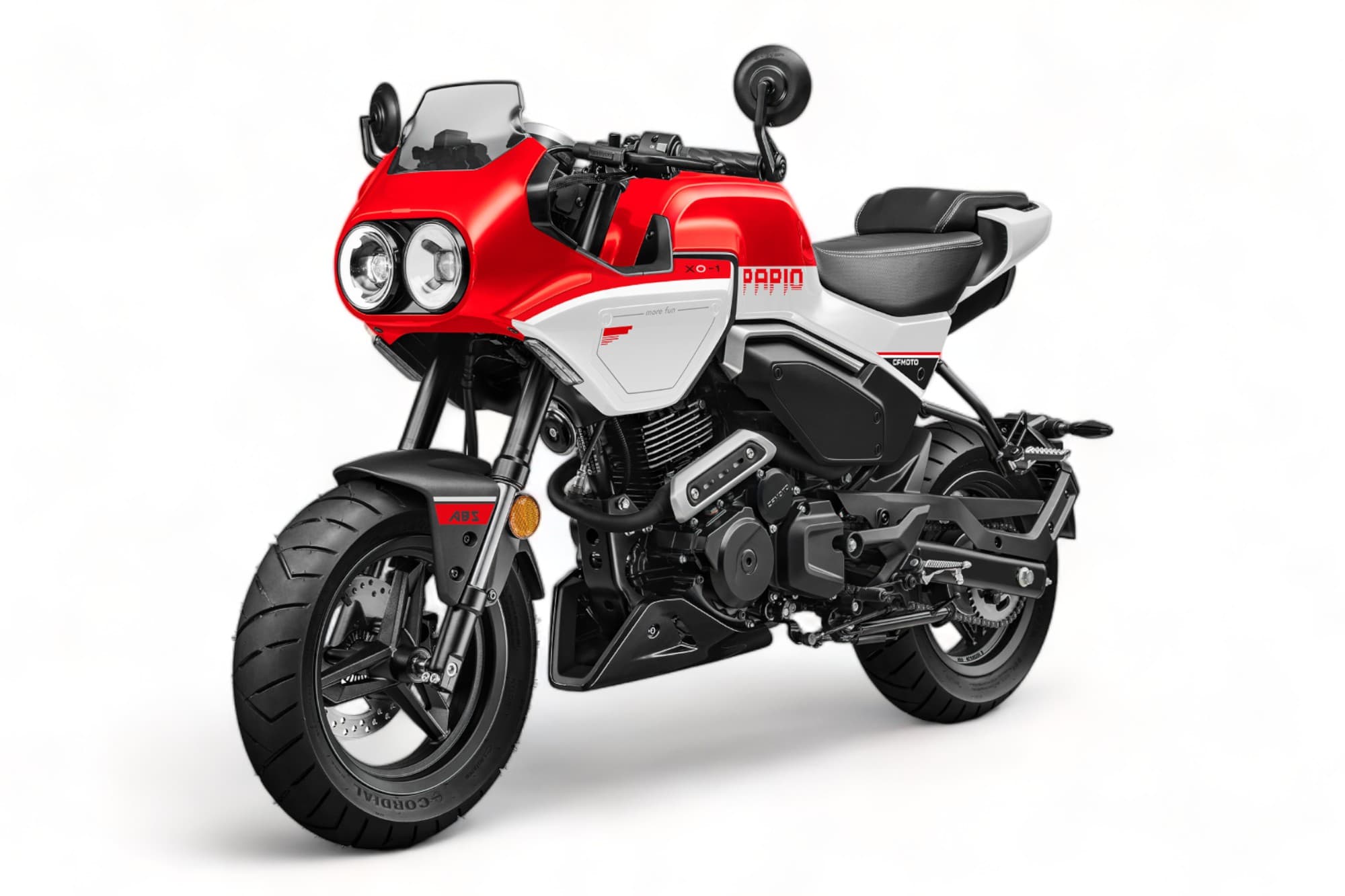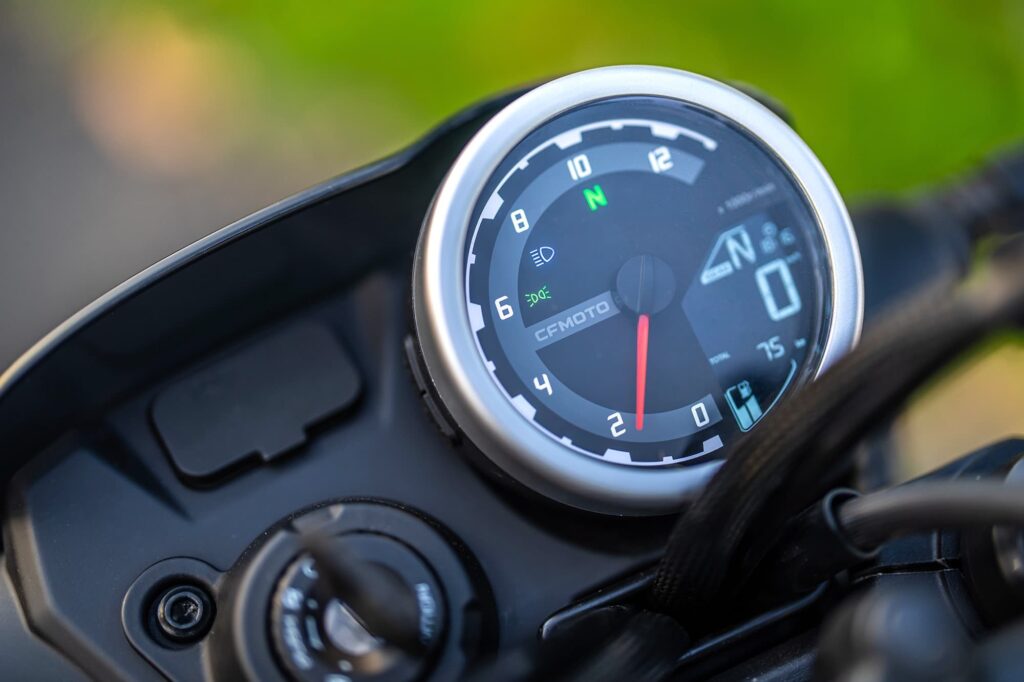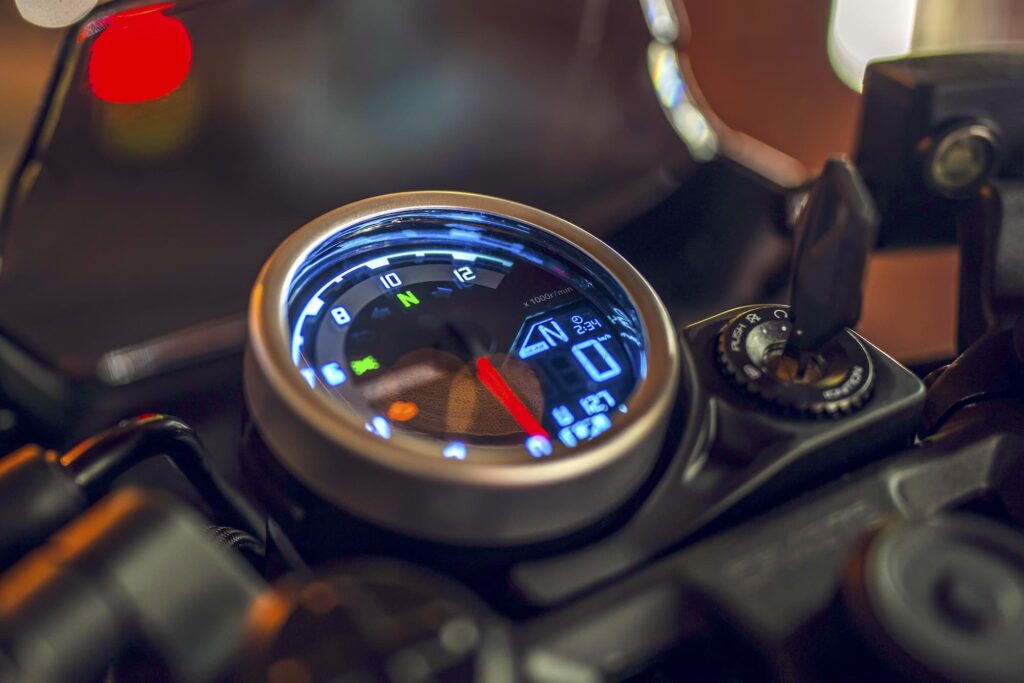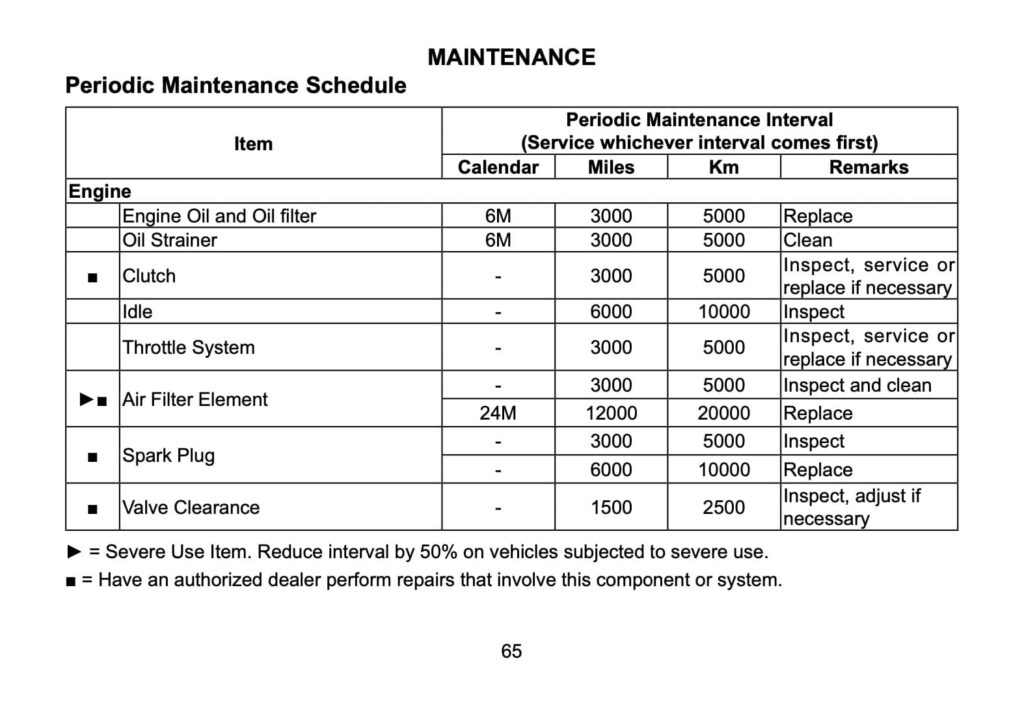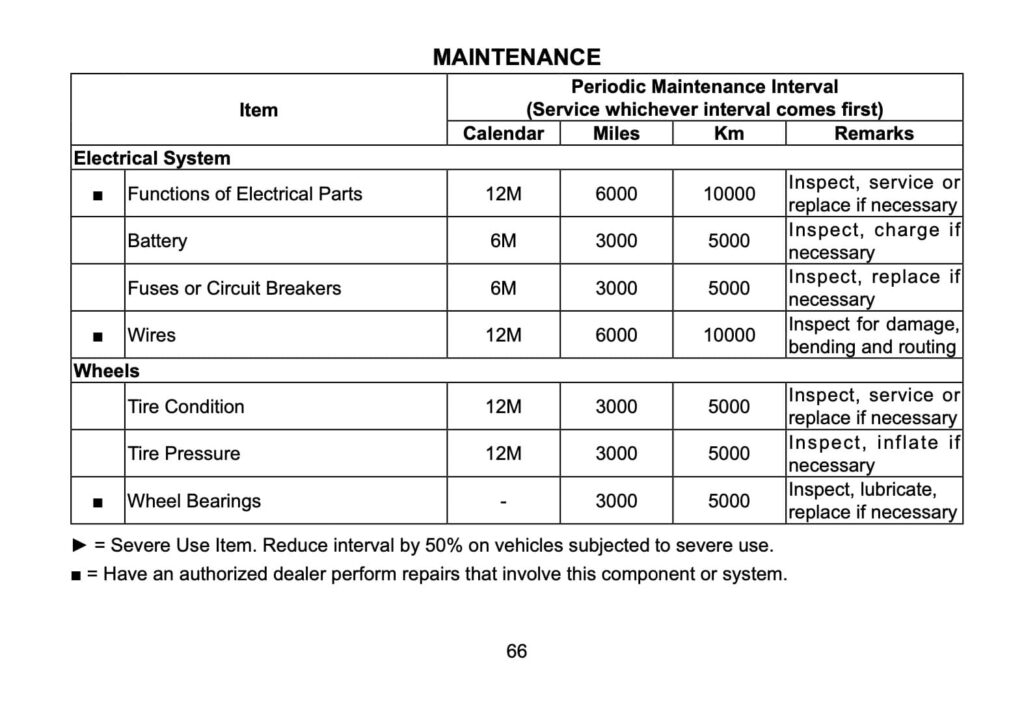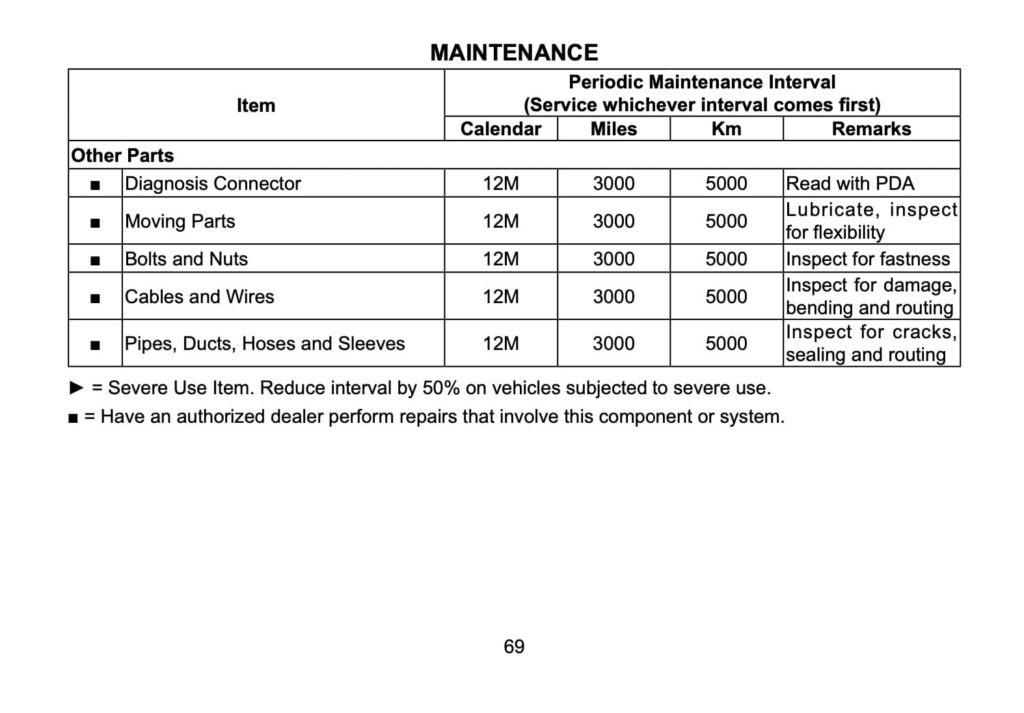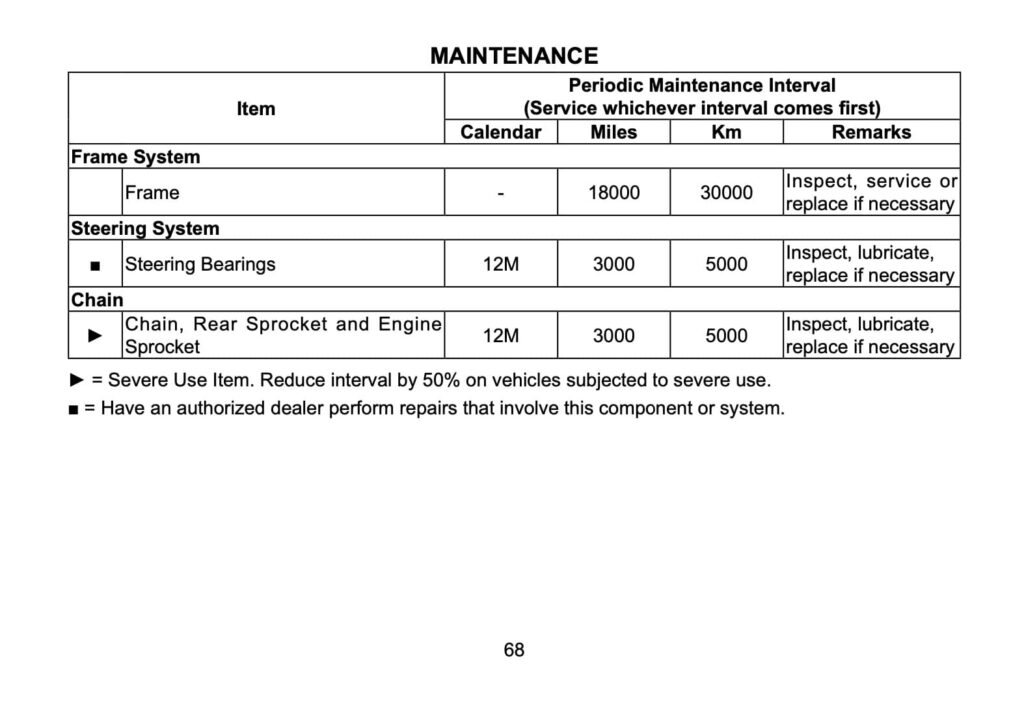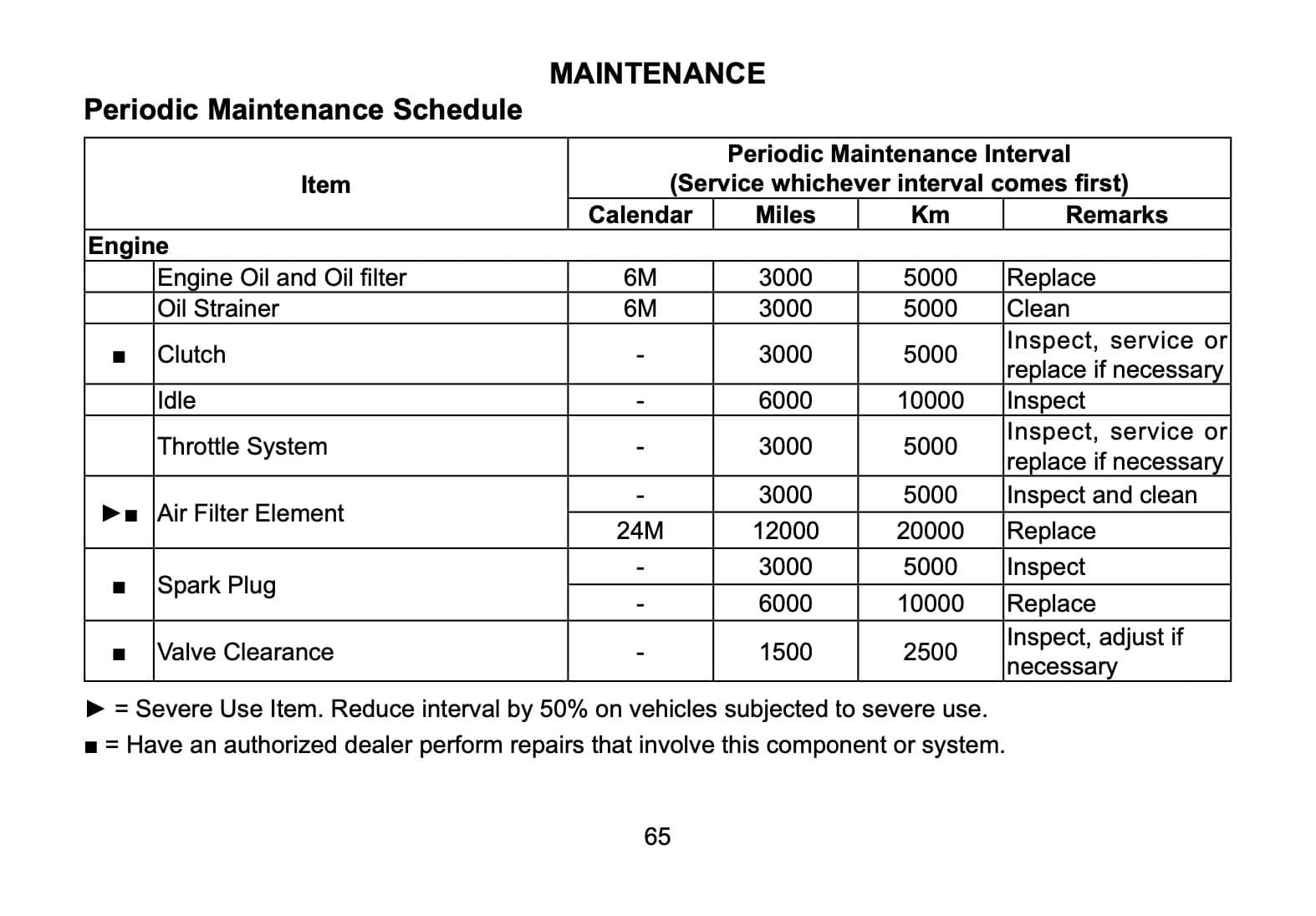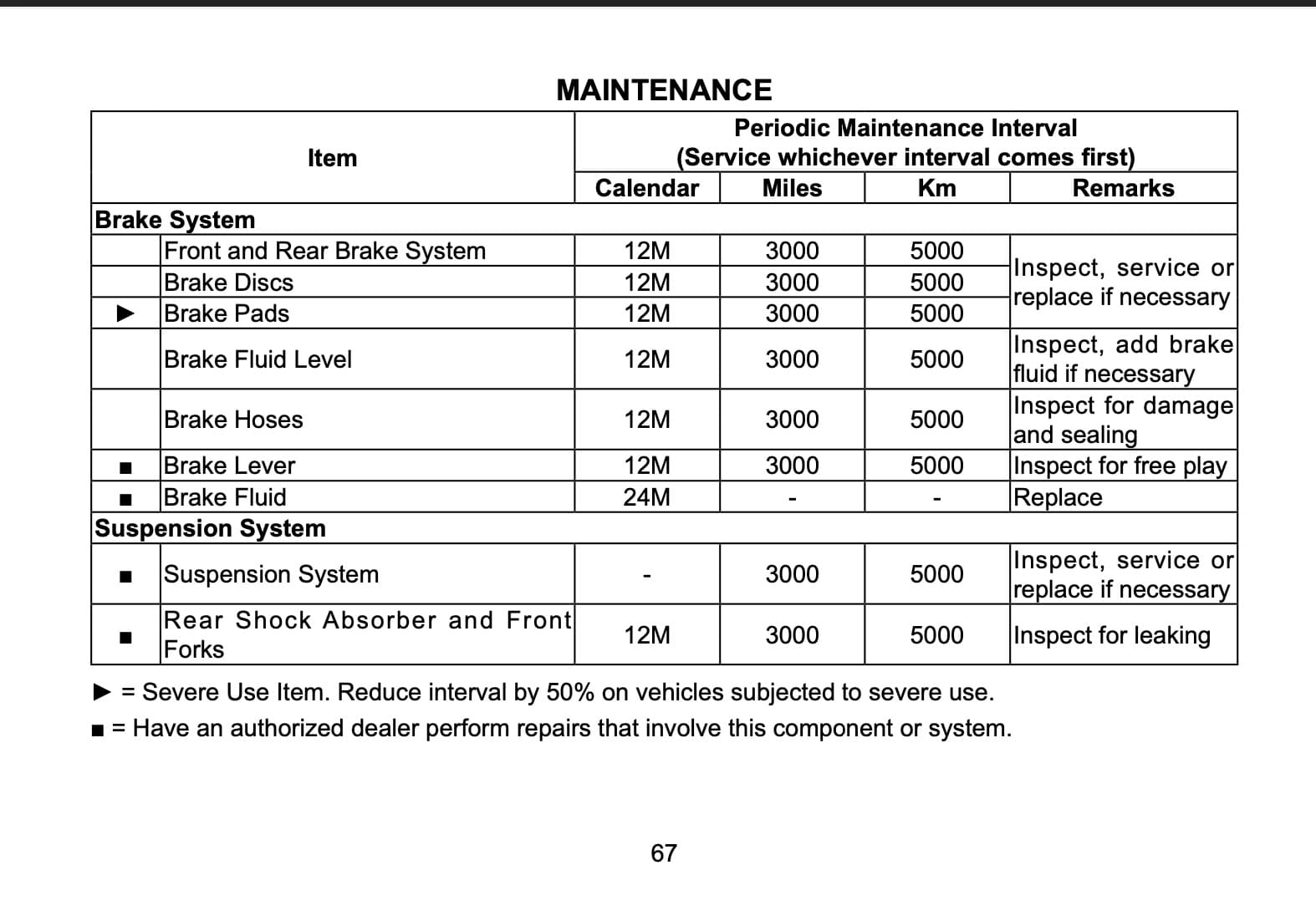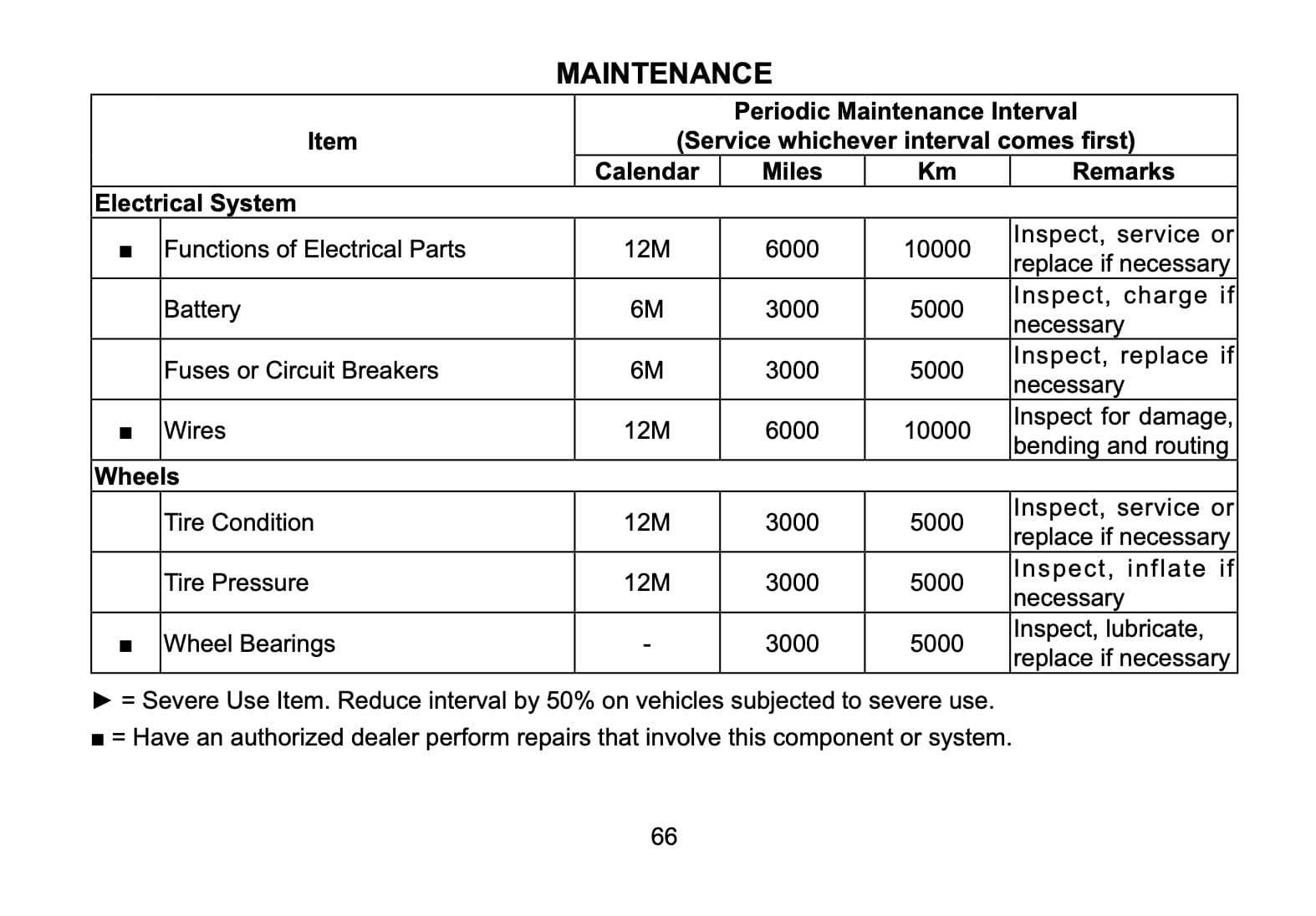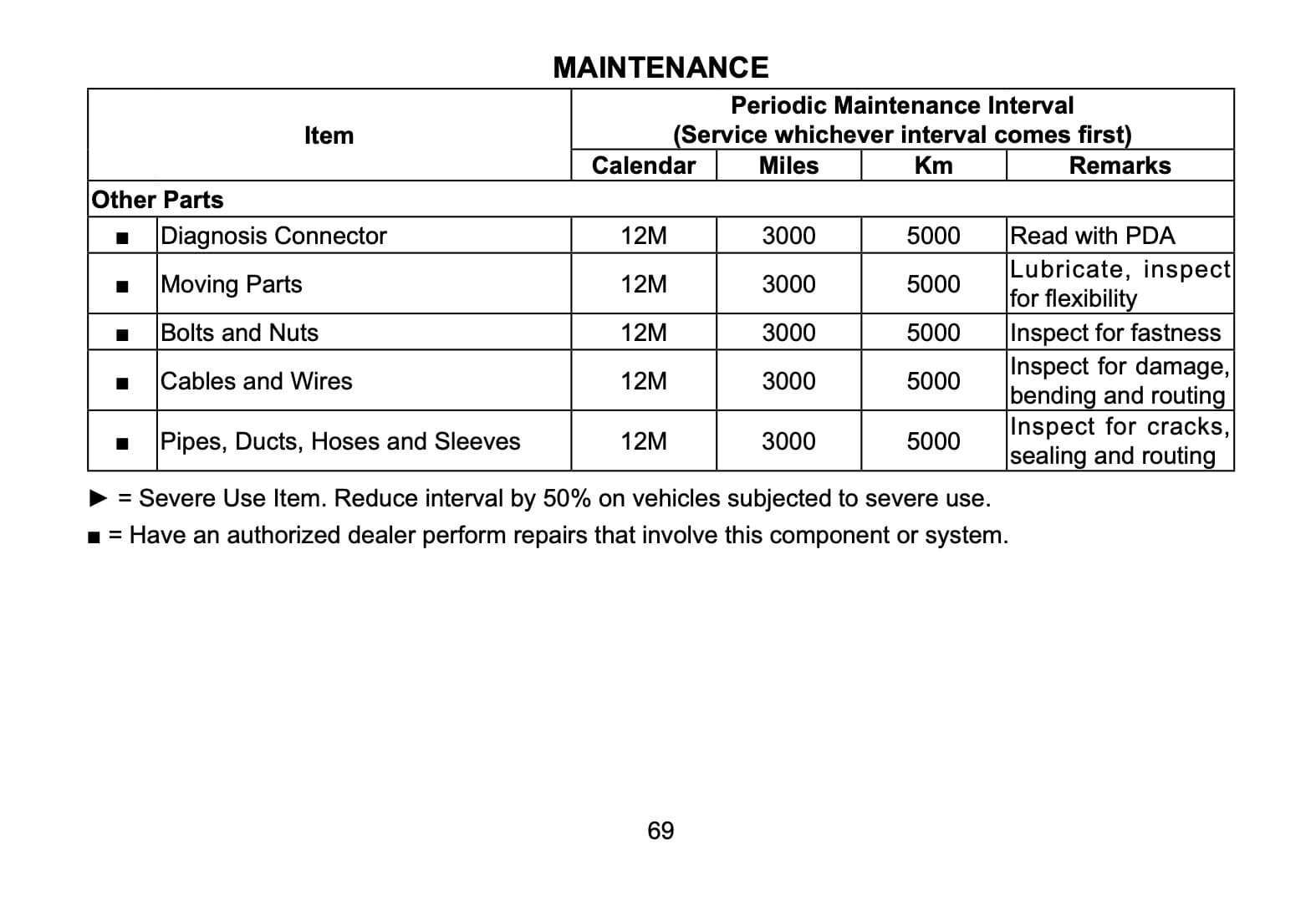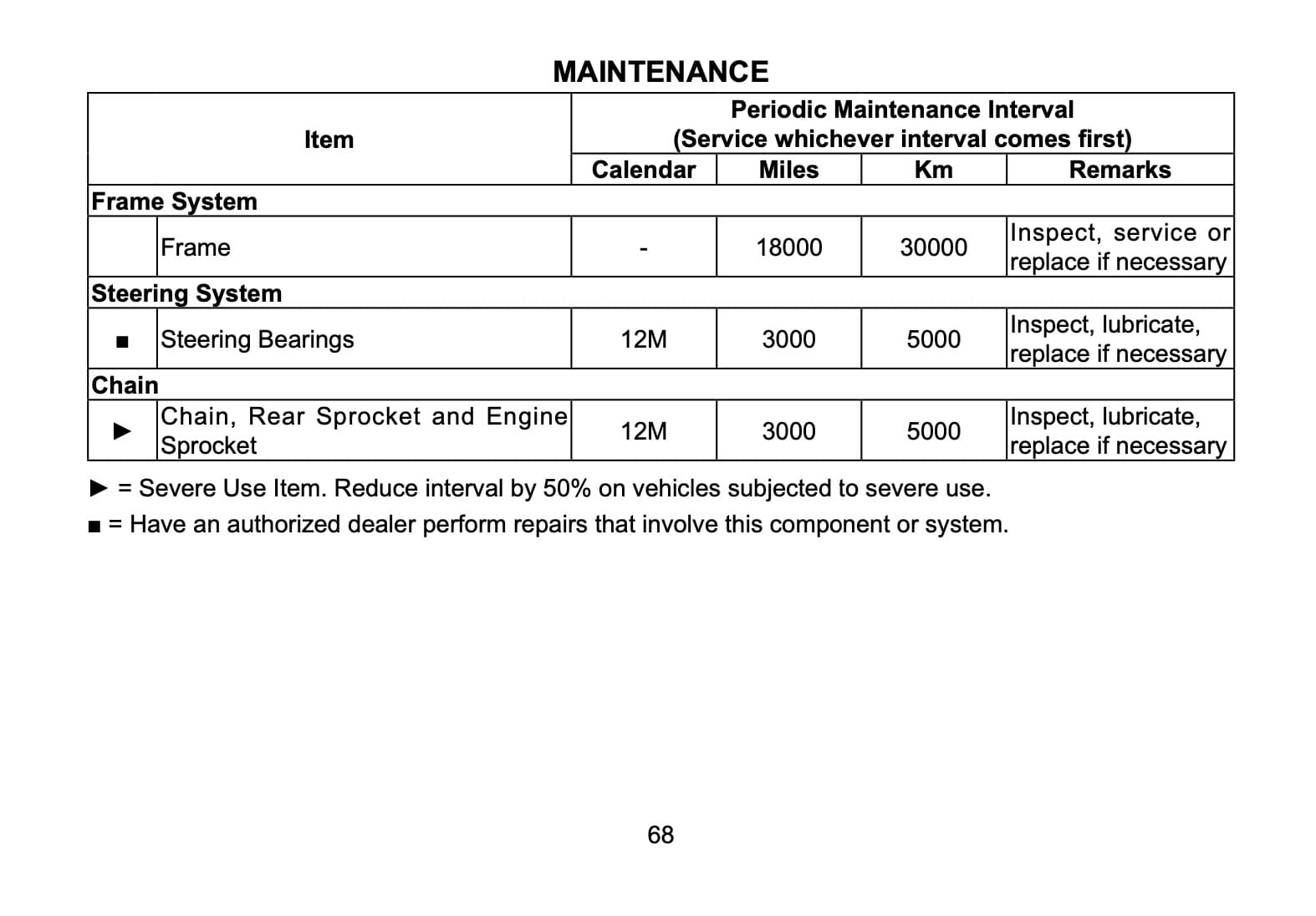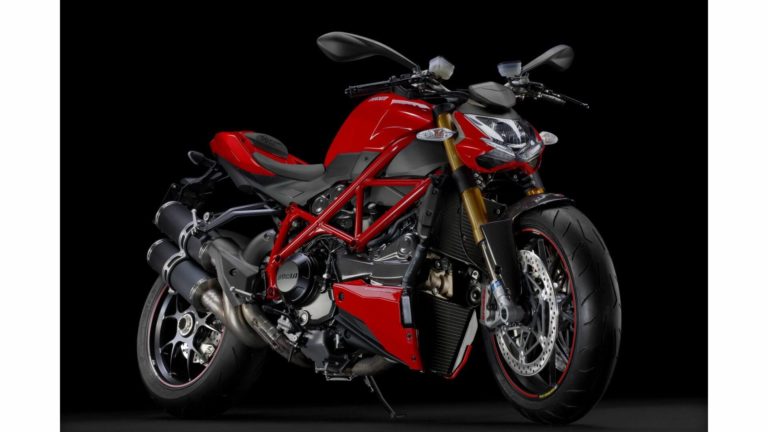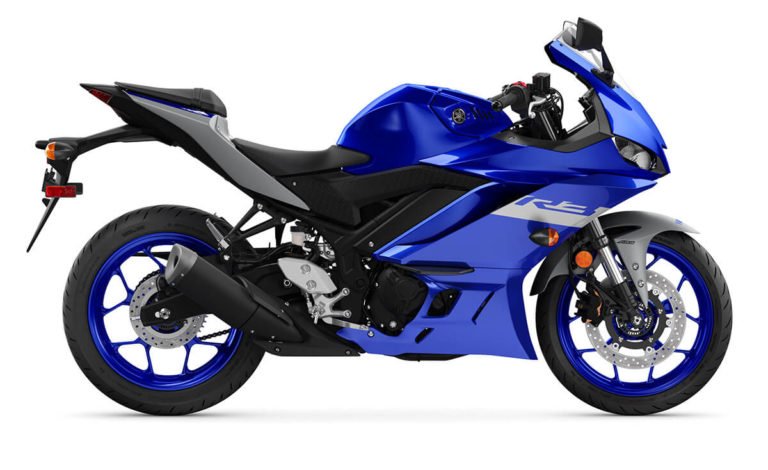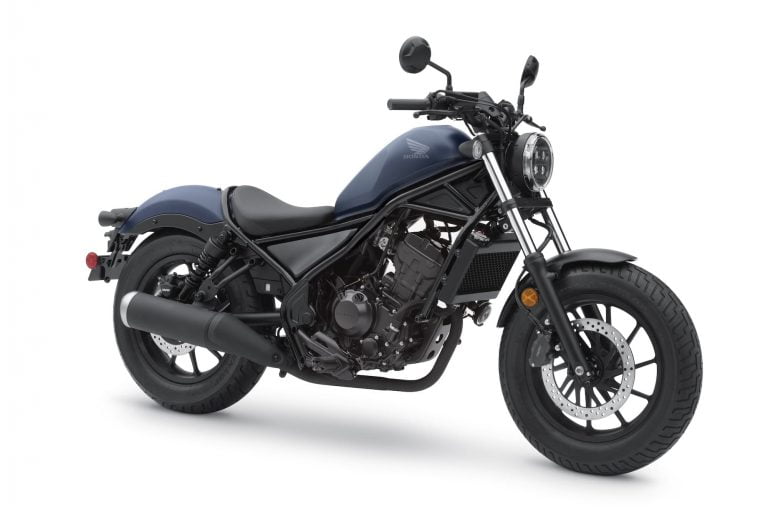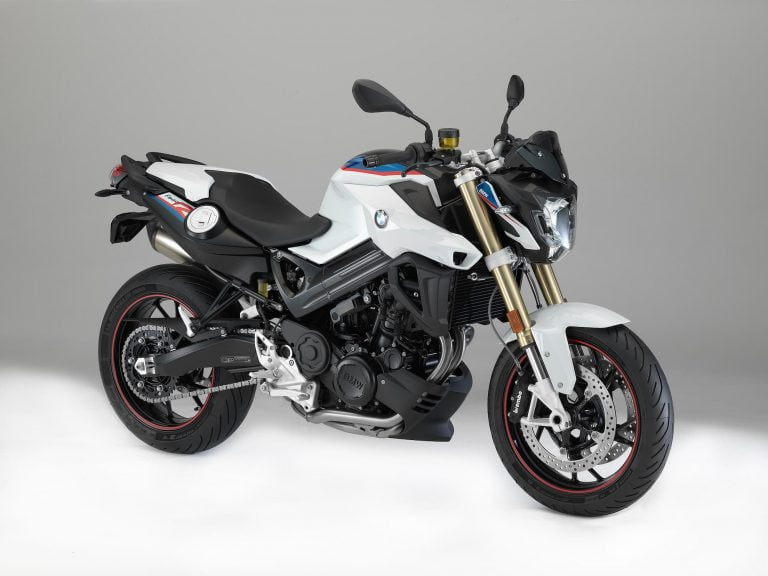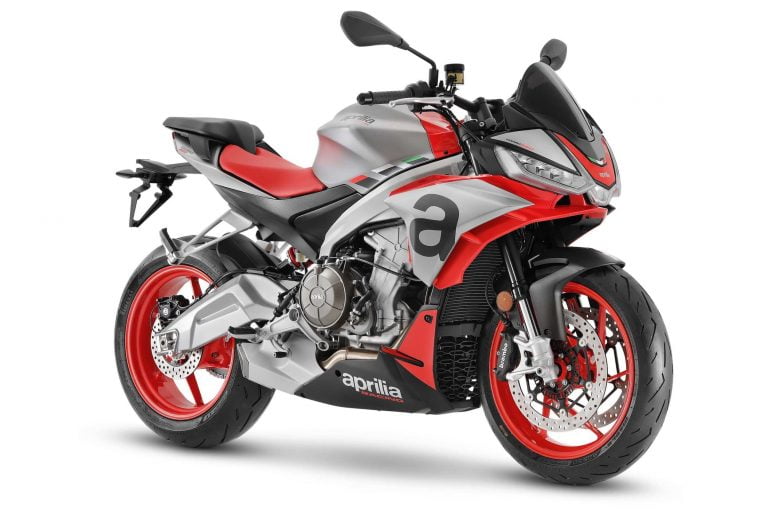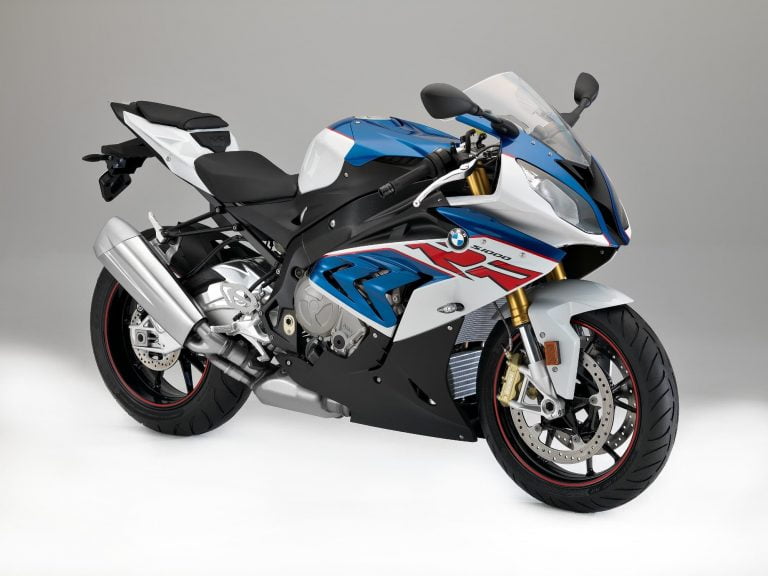CFMOTO XO Papio Trail / Racer (CF125) Maintenance Schedule
This is the maintenance schedule and service information for the CFMOTO XO Papio, CFMOTO’s entry-level motorcycle that comes in two configurations — the scrambler-styled “Trail”, “CL”, or “XO-1”, and the street-styled “Racer”, “SS”, or “XO-2”. Trail and Racer are the easiest to remember as those words correspond best to a visual image, so that’s what we’ll use.
Whatever their names, the CFMOTO XO Papio models are both powered by the same 7.0 kW / 9.4 hp single-cylinder 126 cc air-cooled engine as its sibling. It’s a simple donk, with two valves, a mild compression ratio of 9.0:1, and fuel injection. Final drive is via a 6-speed transmission and a chain. (That’s right — six-speed!)
The only difference between the Racer and Trail is the aesthetic and the handlebar / seat configuration. They come with two different user manuals. But the entire drivetrain, suspension, wheels and other specs are all the same. Because maintenance is 100% the same, their maintenance schedules are combined here.
This site has links from which we earn a commission (which unfortunately nobody can save, not even us). If you appreciate this research work, then please use those links. Thanks.
CFMOTO XO Papio Racer/SS / and Trail/CL Service Intervals
Overall, the CFMOTO XO Papio motorcycles (both SS and CL, both Racer and Trail) have a 3,000 mile / 5,000 km or 6-monthly oil change service interval. At every service, change the oil and oil filter, clean the oil strainer, and check the spark plugs.
Unusually, the valve clearance inspection interval for the XO Papio is half that of the oil change interval — every 1,500 miles or 2,500 km. So between oil changes, you’re expected to crack the cylinder head and inspect or adjust the valve clearance. However, bear in mind that there are just two valves to inspect, and adjustment is via screw and locknut.

There’s no coolant to change. But there is brake fluid, and there’s a chain for the final drive, so there are other components that need frequent attention.
Maintenance Schedule
Below is the maintenance schedule for major items for the CFMOTO XO Papio Racer / Trail. Follow the earlier of time or distance intervals.
| Item | mi x 1000 | km x 1000 | Time |
|---|---|---|---|
| Valve clearances — Inspect / adjust | 1.5 | 2.5 | |
| Inspection checklist — Check all items | 3 | 5 | 1 year |
| Engine oil — Change | 3 | 5 | 6 months |
| Oil filter — Change | 3 | 5 | 6 months |
| Oil filter — Clean | 3 | 5 | 6 months |
| Spark plug — Inspect | 3 | 5 | |
| Spark plug — Replace | 6 | 10 | |
| Air filter — Inspect / Clean | 3 | 5 | |
| Air filter — Replace | 12 | 20 | 2 Years |
| Idle speed — inspect | 6 | 10 | |
| Electrical parts — Check function | 6 | 10 | 1 Year |
| Wires — Check condition and routing | 6 | 10 | 1 Year |
| Wheel bearings — Inspect, lubricate, and replace as necessary | 3 | 5 | |
| Suspension, front and rear — Inspect, service, replace as necessary | |||
| Brake fluid — Replace | 2 years | ||
| Frame — Inspect condition | 18 | 30 |
Inspection checklist
Below is the inspection checklist. Do the items on this list at every service interval.
| CFMOTO XO Papio — Inspection Checklist |
|---|
| Clutch — Inspect, adjust free play, service or replace as necessary |
| Throttle system — Inspect, adjust or replace as necessary |
| Battery — Check voltage and charging |
| Fuses / circuit breakers — check |
| Tires — Check condition |
| Tires — Check pressure, adjust as necessary |
| Brake system — Check function, front and rear Front brake lever travel: 10-15 mm (0.39-0.59 in) Brake pedal travel: 10-20 m (0.39-0.79 in) |
| Brake discs — Check wear level (minimum 3 mm / 0.12 in) |
| Brake pads — Check wear level (minimum 2.5 mm / 0.1 in) |
| Brake fluid level — Check (should be between lines), top up as necessary |
| Brake hoses — Check for damage and sealing |
| Brake fluid level — Check, top up as necessary |
| Front forks and rear shock — Inspect for leaks |
| Steering bearings — Inspect, lubricate, replace as necessary |
| Chain and sprockets (front and rear) — Inspect, lubricate, replace as necessary |
| Diagnosis connector — Read with PDA |
| Moving parts — Lubricate, inspect for flexibility |
| Bolts and nuts — Check for tightness |
| Cables and wires — Check for damage, bending, and routing |
| Pipes, ducts, hoses, and sleeves — Inspect for cracks, sealing, and routing |
Maintaining Your Chain on the CFMOTO XO Papio
Because the CFMOTO XO Papio is a low-cost motorcycle, people tend to forego essential maintenance maybe a little more easily than they would their pride and joy. But the Papio’s chain needs the same love — especially as you’re likely to ride it in all kinds of conditions.
In particular, if you ride the XO Papio Trail off-road, you should clean the chain every time it gets dirty or wet, and consider re-lubricating it. But generally speaking, it’s good to do this every 600 mi / 1000 km per the manual, or more often as necessary
Use a good-quality chain lubricant like Motul chain paste, or a Motul chain care kit which comes with a couple of handy tools to maintain the chain.
| Chain maintenance (every 600 mi / 1000 km) |
|---|
| Check drive chain lubrication condition, lubricating if necessary (Motul chain paste) |
| Check drive chain slack, alignment, and condition, adjusting / replacing if necessary (See below notes) |
To check the slack on the CFMOTO XO Papio motorcycles, put your bike in neutral, onto its kickstand, and on a level surface.
Check the slack on the lower part of the chain, midway between the sprockets, and check it in multiple places (move the motorcycle forwards and backwards) as chains wear unevenly.

Slack on the CFMOTO XO Papio is defined as the free vertical movement of the chain.
Target chain slack for the CFMOTO XO Papio (Trail / Racer): 30 – 40 mm (1.18 – 1.57 in)
If the chain slack is out of spec, you need to adjust it.
Adjusting chain slack
To adjust the chain slack on the CFMOTO XO Papio, you follow the same steps you would on a large number of motorcycles with a standard swingarm and sliding rear axle.
As when measuring chain slack, make sure that the motorcycle is on a level surface on its kickstand, in neutral, with no weight on it (no saddlebags / luggage).
- Loosen the rear axle shaft nut and the adjuster lock nuts on both sides of the axle.
- Turn the adjuster nuts to tighten (or loosen) the chain. Keep checking the chain tension to see if it has come within spec.
- Keep an eye on the adjuster alignment marks on either side of the axle. Make sure that the adjustment is to the same point.
- When you’re done, tighten the axle to 90 Nm / 66.4 lb-ft.
- Re-check the chain slack again to make sure it’s still within spec.
Wheels and Tire Pressures
The CFMOTO XO Papio Racer and Trail both come with the same tubeless tires and have the same recommended tire pressures from the manual as standard.
| Wheel | Tire size | Tire pressure (cold) |
|---|---|---|
| Front | 120/70-12 51L | 29 psi / 200 kPa |
| Rear | 130/70-12 56L | 32.6 psi / 225 kPa |
Naturally, you can adjust these tire pressures to suit your riding style. Whether you’re riding the Trail off road or the Racer on a track, you might want to lower your pressures in each situation.
About the CFMOTO XO Papio SS / Trail
The CFMOTO XO Papio is a pair of attractively designed, basic and functional motorcycles from Chinese manufacturer CFMOTO. They’re essentially like the Honda Grom, with two important differences: They unabashedly have a lot more hipster cool in their design, and you can still get them everywhere (the Grom is vanishing from a few markets).
The core of both motorcycles is exactly the same. They have the same engine, chassis, suspension, wheels, headlights, and instrument cluster. The only thing that’s different is their handlebar position and style.
The CFMOTO Papio CL (or Trail) is the naked / “Scrambler”- style motorcycle of the pair. It has handlebars and a slightly more upright seating position.
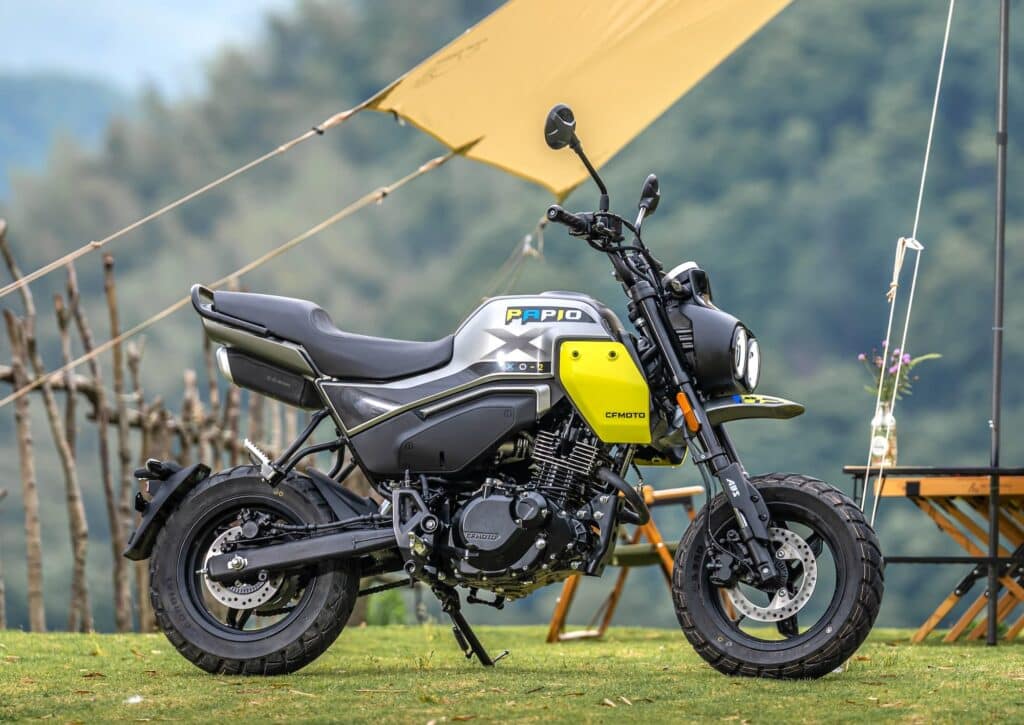
The SS or the Racer has lower bars and a small fairing.

The 126 cc single-cylinder engine is the same in both. It makes 7 kW / 9.4 hp at 8250 rpm, with decent torque from down low (being a single with two valves). Fuelling is via fuel injection and there’s ABS — but that’s about it in terms of tech on the bike.
The engine is a high-revving one, you might notice. It is one that like to be revved, and the stock exhaust sounds good, encouraging you to take it there.
The gauge on both bikes is a mixed analogue/digital gauge. Just enough tech to keep you interested! CFMOTO did put the key in a different position on each bike, though.
A lot of how you might describe the CFMOTO XO Papio bikes would be best described by answering questions.
- Is it slow? You probably can’t do the ton, even in metric units. It’ll stop just shy of (or at) 100 km/h or 60 mph. So don’t take it on interstates or freeways on long trips.
- Can you wheelie it? Definitely. It has a pretty short first gear, which is explicitly there
for wheeliesto help new riders launch without stalling. - Is it light? Yes, unless you’re expecting it to be like an e-bike. Both the Trail and Racer have a fully fuelled weight of 114 kg / 250 lb.
- Is it too small for taller riders? You might notice that most of the marketing materials have compact people riding them. But I’ve also seen riders around the six-foot level on them, and they don’t look silly. It’s comfortable if you are OK with bending your knees like you would on a standard (not even as much as you would on a 600 cc supersport). It’s not a pit bike. However, if you’re at all concerned, just sitting on one will tell you everything.
- Is it too small in general? Yes, it’s lightweight in the sense that if a big truck blows past you, you’ll feel it.
- Does it look cool? YES!!
The CFMOTO XO Papio looks good enough (whether in Trail or Racer format) that many people are saying “Please build me this in a bigger format!” There’s a lot that’s cool about the design, particularly of the Racer / SS / XO-2:
- The “Playstation control”- design headlights
- The bar-end mirrors
- The under-seat exhaust!
The CFMOTO Papio bikes are excellent introductions to the world of motorcycle maintenance for people who want to learn their way around an engine in the garage as much as they want to learn how to ride.
Because the Papio bikes are affordable, lightweight, and simple, they’re harder to screw up when maintaining them. You’re not going to fling these around at triple digit speeds, so it’s OK if you mess up things like the torque on the rear axle bolt (just do it up tight!) or get the chain slack adjustment slightly wrong.
The best part is that the valve job is easy to do, being screw and locknut. The not-so-good part is that the manual doesn’t specify the valve clearance or the adjustment procedure.
The worst part is how often you’ll do it. Every 1500 miles / 2500 km?? This means that if you commute on your CFMOTO XO Papio you’ll adjust the valves several times a year — at least! Buying the Papio means buying into maintaining it at home — but the manual says you should get a dealer to do the service. Absolutely buy a service manual (from CFMOTO here) if you’re buying this bike. It’s $39.99 in the US, which will cost far less than your first service.
This is where I’d caution second-hand buyers of the CFMOTO Papio bikes. There’s a growing tendency for people to buy motorcycles of this price point and just never maintain them. No oil changes, no chain maintenance, and definitely no valve clearance checks. People buy them and ride them into the ground, or sell them shortly beforehand. I’ve seen it with a lot of motorcycles like the Honda 125-cc bikes used as delivery motorcycles, for example. Caveat emptor, always.
Reference — Manual Screenshots
The above came from the manuals for the CFMOTO Papio SS and Papio CL. Below are screenshots of the service schedule for the CFMOTO XO from the manual for the Papio Racer. This section is identical to that of the Racer Trail (I checked)
You can download manuals for CFMOTO motorcycles at CFMOTO USA here. They’re largely in imperial units but the metric conversions are in there too.
